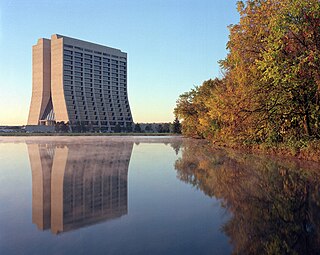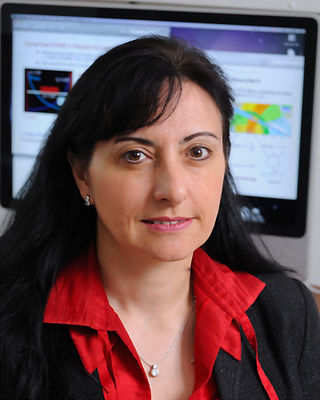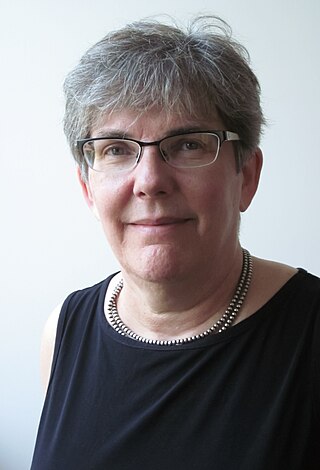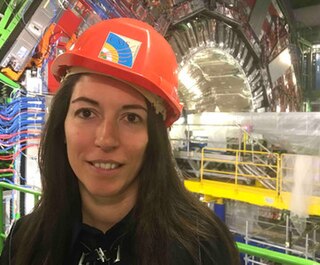Related Research Articles

The Collider Detector at Fermilab (CDF) experimental collaboration studies high energy particle collisions from the Tevatron, the world's former highest-energy particle accelerator. The goal is to discover the identity and properties of the particles that make up the universe and to understand the forces and interactions between those particles.

The DØ experiment was a worldwide collaboration of scientists conducting research on the fundamental nature of matter. DØ was one of two major experiments located at the Tevatron Collider at Fermilab in Batavia, Illinois. The Tevatron was the world's highest-energy accelerator from 1983 until 2009, when its energy was surpassed by the Large Hadron Collider. The DØ experiment stopped taking data in 2011, when the Tevatron shut down, but data analysis is still ongoing. The DØ detector is preserved in Fermilab's DØ Assembly Building as part of a historical exhibit for public tours.

Nigel Stuart Lockyer is a British-American experimental particle physicist. He is the current director of the Cornell Laboratory for Accelerator-based ScienceS and Education (CLASSE) as of May 1, 2023. He was the Director of the Fermi National Accelerator Laboratory (Fermilab), in Batavia, Illinois, the leading particle physics laboratory in the United States, from September 2013 to April 2022.

Joseph David Lykken is an American theoretical physicist at the Fermi National Accelerator Laboratory and, from July 1, 2014 to Sept 6, 2022, he was the Deputy Director of Fermilab. He is currently Director of Fermilab's Quantum Division.

Marcela Silvia Carena Lopez is an Argentine theoretical physicist, and since November 2024 the Executive Director of the Perimeter Institute for Theoretical Physics in Waterloo, ON, Canada. Prior to taking this position she was a Distinguished Scientist at the Fermi National Accelerator Laboratory in Batavia, Illinois, where she was Director of the lab's Theory Division. She is also a professor at the University of Chicago, where she is a member of the Enrico Fermi Institute and the Kavli Institute for Cosmological Physics.

Young-Kee Kim is a South Korea-born American physicist and Albert Michelson Distinguished Service Professor of Physics at the University of Chicago. She is 2024 President of the American Physical Society.
Ann Heinson is an American high-energy particle physicist known for her work on single top quark physics. She established and led the DØ Single Top Group which first published experimental observations of the top quark, and in 1997 she co-authored a paper which laid the foundations for further investigation into the top quark.
Juliet Lee-Franzini was a Chinese-born physicist who was the founding faculty member of the high energy physics experimental group at Stony Brook University.

Heidi Marie Schellman is an American particle physicist at Oregon State University (OSU), where she heads the Department of Physics. She is an expert in Quantum chromodynamics.
Marjorie Diane Blasius Corcoran was an American particle physicist and professor at Rice University.

Yaşar Önel is a Turkish-born physicist who holds Swiss and American citizenship. He received his Ph.D. in Physics from London University in 1975. He worked at the Queen Mary University of London in the United Kingdom, and Neuchatel and Geneva Universities in Switzerland before joining the University of Texas at Austin in 1986. Then, he moved to the University of Iowa in 1988. He is a tenured faculty professor. of Physics at the University of Iowa in Iowa City, IA, USA.
Tulika Bose is a professor of physics at the University of Wisconsin-Madison, whose research focuses on developing triggers for experimental searches of new phenomena in high energy physics. Bose is a leader within the Compact Muon Solenoid (CMS) experiment, a CERN collaboration famous for its experimental observation of the Higgs boson in 2012.

Bradley Cox is an American physicist, academic and researcher. He is a Professor of Physics and the founder of the High Energy Physics Group at the University of Virginia.
Aida Xenia El-Khadra is a particle physicist who is a professor of high energy physics at the University of Illinois at Urbana–Champaign. She is the co-chair of the Muon g-2 Theory Initiative, which reported hints at new physics in the Standard Model in 2021. She is a fellow of the American Physical Society and the Alfred P. Sloan Foundation.

Meenakshi Narain was an Indian-born American experimental physicist. She was a Professor of Physics and Chair of the Department of Physics at Brown University, and was also Chair of the Collaboration Board of U.S. institutions in the Compact Muon Solenoid (CMS) Collaboration. She contributed to the discovery of the top quark in 1995 and Higgs Boson in 2012.

Sarah C. Eno is an American experimental particle physicist at the University of Maryland, College Park, where she is a professor of physics and UMD Distinguished Scholar–Teacher. She has participated in several large experimental collaborations in high-energy physics, including the AMY experiment at the Japanese TRISTAN particle accelerator, the DØ experiment at Fermilab in the US, the Collider Detector at Fermilab, and the Compact Muon Solenoid experiment at the Large Hadron Collider in France and Switzerland.
Alice Louise Bean is an American physicist whose research concerns particle physics, and particularly particles beyond those predicted from the standard model of particle physics. She is a distinguished professor of physics at the University of Kansas.

Florencia Canelli is since 2021 the appointed Swiss scientific delegate to the CERN council, the supreme decision-making authority of the CERN Organization. From 2021-2024, she was appointed chair of the IUPAP division of particles and field (C11). From 2021-2023, she was co-coordinator of the physics program of the CMS collaboration, a CERN experiment with over 3000 physicists. In 2010, Canelli was awarded the IUPAP Young scientist prize, an international prize awarded to one experimental and one theoretical physicist per year, for "her pioneering contribution to the identification and precision measurements of rare phenomenon through the use of advanced analysis techniques to separate very small signals from large background processes at the Tevatron collider." She has been an author on four multi-purpose collider experiments, namely the CMS experiment and ATLAS experiment at the CERN LHC, and the CDF experiment and D0 experiment at the Fermilab Tevatron. She is currently a full professor at the University of Zurich, Physics Institute, specializing in particle physics.
Freya Blekman is a Dutch professor at the University of Hamburg and the lead scientist at Deutsches Elektronen-Synchrotron (DESY). She contributed to the discovery of the Higgs boson at CERN and has been endowed the Helmholtz Distinguished Professorship. Her individual work specializes in the physics and experimental aspects of elementary particles and fields, specifically looking at the top quark sector by using precision measurements.
Christopher Scott Hill is an American particle physicist and Professor of Physics at The Ohio State University. He is known for his contributions to the study of the top quark and for co-founding the milliQan Experiment at the Large Hadron Collider.
References
- 1 2 3 "Cecilia Gerber, PhD", Profiles, UIC Physics, retrieved 2022-01-30
- ↑ "Cecilia Gerber of UIC appointed to second term as LHC Physics Center co-coordinator", Fermilab at Work, 31 January 2019, retrieved 2022-01-30
- 1 2 Daley, Jim (8 October 2019), "Raising a new set of flags at Fermilab", Symmetry, retrieved 2022-01-30
- 1 2 "Cecilia Elena Gerber", INSPIRE author profile, retrieved 2022-01-30
- ↑ "Fellows nominated in 2010 by the Division of Particles and Fields", APS Fellows archive, American Physical Society, retrieved 2022-01-30
- ↑ 2021 Fellows, American Association for the Advancement of Science, retrieved 2022-01-30